![MRR Growth: What is It and How to Calculate It [+ Other Growth Metrics] cover](https://blog-static.userpilot.com/blog/wp-content/uploads/2023/10/mrr-growth-what-is-it-and-how-to-calculate-it_12eb07fe6054aeca5f2b2610c20298a6_2000.png)
If you’re trying to figure out how quickly your SaaS business is growing, MRR growth rate is the answer. A simple yet effective answer to all your growth-related questions.
Net monthly recurring revenue (MRR) growth enables you to calculate the change in your company’s recurring revenue on a month-to-month basis.
As we will see in this article, there are several key factors that affect monthly revenue. Net MRR growth rate helps calculate the variation across these factors, so you end up with a clear indicator of your company’s growth.
How do you currently identify and fix drop-off points in your conversion funnel?
Try Userpilot Now
See Why 1,000+ Teams Choose Userpilot

What is the monthly recurring revenue (MRR) growth rate?
If you’re a subscription-based SaaS company, you will have recurring revenue streams you receive each month from customers who sign up for your product. However, there can always be variations in that revenue, mostly because of:
- Upgrades/downgrades from existing customers
- Churn
- New paying customers
As a result of these variations, your recurring revenue will fluctuate, and so will your growth rate. That’s what the monthly recurring revenue (MRR) growth rate is – the net increase or decrease in recurring revenue on a monthly basis. A similar concept is ARR, annual recurring revenue.
Why should you track the MRR growth rate?
Now that you know what the MRR growth rate really is, let’s look at why it’s so important to keep track of it.
- Indicative of SaaS growth: The growth rate helps you compare your company’s performance to last month, thereby letting you know whether you’re doing better or worse.
- Track product financial health: Knowing how your product is performing, in terms of revenues gained or lost, is crucial to help with financial forecasting and planning.
- Assess the impact of growth strategies: You won’t know if the new growth strategy you implemented last month is working unless you have a metric, like MRR, to prove it.
How to calculate MRR growth rate?
To calculate MRR growth rate, you first need to calculate net MRR, which requires the following data:
- New MRR: Added monthly recurring revenue earned from new subscriptions that month.
- Reactivation MRR: Revenue earned that month from reactivated subscriptions that had previously been canceled or lost.
- Upgrade MRR: Revenue earned when existing subscriptions sign up for a higher plan that month.
- Contraction MRR: Total decrease in monthly recurring revenue due to downgrades to lower plans or cancellations (customer churn) that month.
Now that you know what everything means, you can just plug in the values in the net MRR formula below:
Net MRR = (New MRR + Reactivation MRR + Upgrade MRR) – (Cancellation MRR + Downgrade MRR)
Next, you can calculate the net MRR growth rate using the following formula:
MRR Growth Rate = [(Net MRR of Current Month – Net MRR of Last Month) / Net MRR of Last Month] * 100
Let’s look at an example to better understand.
Suppose your net MRR in July was $1300. During August, you gained $800 in new MRR, $400 in reactivation MRR, and $600 in upgrade MRR. You also incurred a loss of $300 due to customer churn (contraction MRR).
For August, your net MRR will be: (800 + 400 + 600) – 300 = $1500
Using this, we can determine the net MRR growth rate for August as: [(1500 – 1300) / 1300] * 100 = 15%
Net MRR growth rate benchmarks
How can you know if your net MRR growth rate is good or bad?
While there isn’t a definite answer as to what constitutes a “good” MRR growth rate, industry experts recommend that SaaS and subscription-based startups aim for a 10-20% net MRR growth rate.
However, not many achieve 20%, with most SaaS companies falling in the 10-15% range instead.
How to drive monthly recurring revenue growth
The straightforward answer to net MRR growth would just be to attract more customers, right? But alas, we all know acquiring new customers is never that easy!
Worry not, because there are several other ways you can grow your net MRR.
You could improve your conversion funnel, focus on expansion MRR growth, create value for existing customers, or lower churn. Let’s elaborate on all these points, and more, below.
Analyze and optimize conversion funnels
If you have a leaky conversion funnel, fewer customers are going to actually sign up and contribute to the monthly recurring revenue.
So, to start things off, conduct a conversion funnel analysis to figure out drop-off points where users abandon the funnel.
A general best practice to boost conversion is to focus on these friction points, such as an unnecessarily long sign-up page, for easy wins.
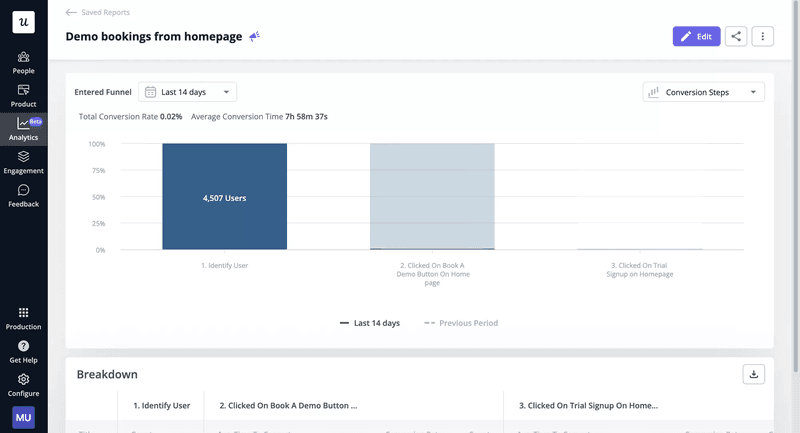
A/B test to increase conversion rate
A/B testing lets you figure out which variation of your product or content performs better.
This can help you increase conversions and, therefore, improve MRR.
A good example of A/B testing is running a head-to-head test of two user in-app experiences. Make two versions and track which one results in higher conversions of your desired goal.
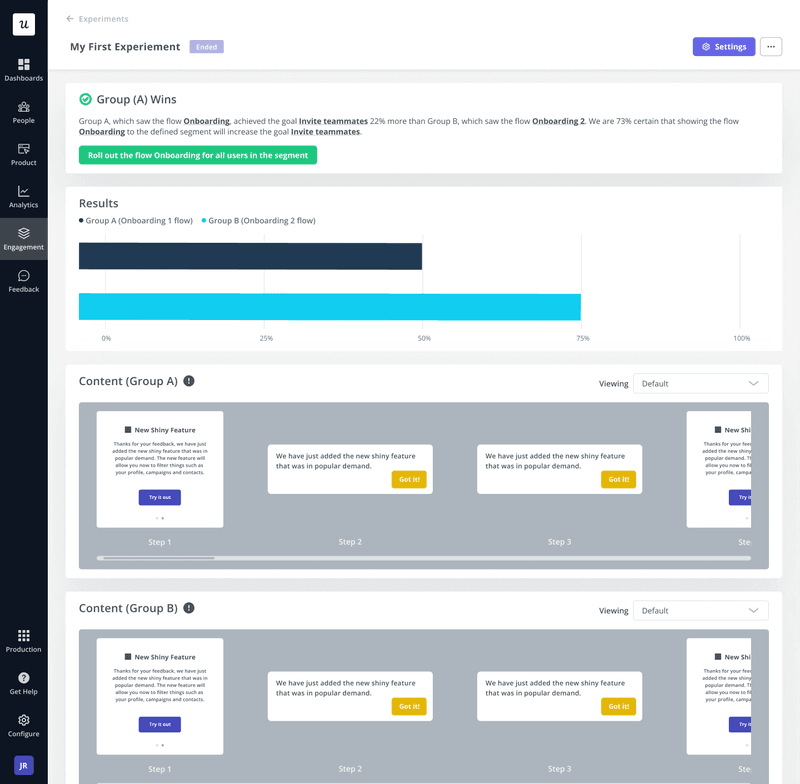
Trigger upgrade messages to drive expansion MRR
Focusing on expansion MRR is a great way of driving MRR growth because it brings in more revenue while negligibly adding to your costs.
A common way of achieving expansion MRR growth is by upselling. You can do this by setting up trigger conditions, which, if met, automatically send the customer an upselling message. The condition could be anything, from onboarding completion to the end of the free trial.
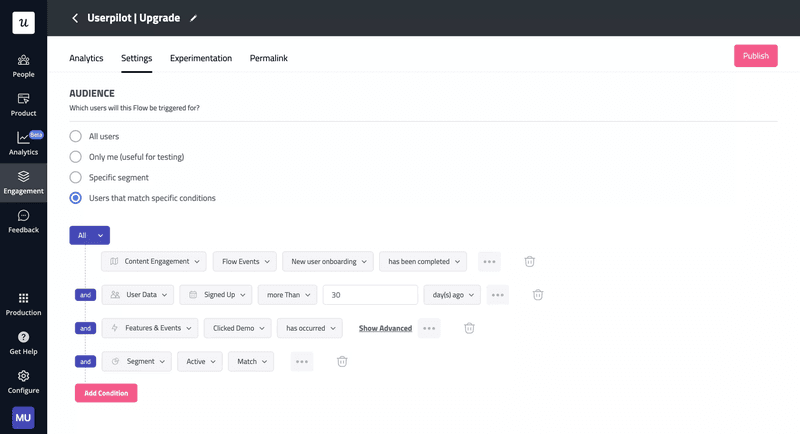
Drive repeated value for existing customers
You don’t always have to target new customers to improve your net MRR growth rate. You can also focus on helping existing customers unlock more value. The more value they derive, the more net MRR growth you achieve.
Delivering in-app guidance is an effective way of accomplishing this, especially during the onboarding phase when customers are going through product tutorials.
You can also create value during later stages by implementing tooltips that introduce new and advanced features to customers.
Disclaimer: The tooltip below wasn’t built by Miro, it’s a simple hypothetical example to show how easy it is to use Userpilot’s Chrome extension to build tooltips.
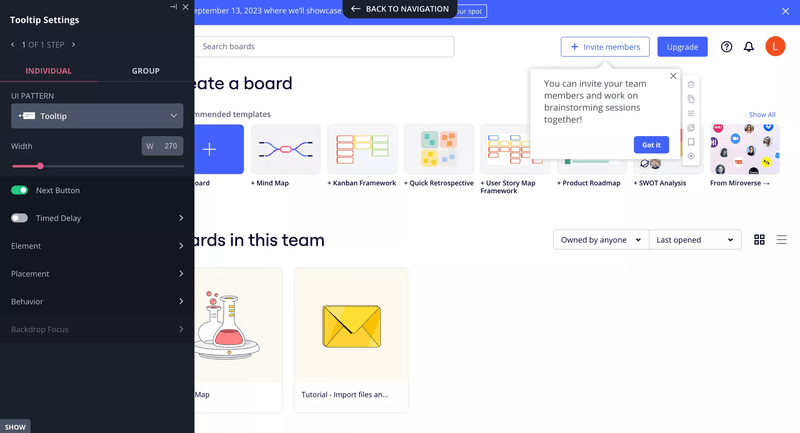
Monitor customer behaviors to prevent churn
Lastly, in order to drive growth, you need to lower your churn rate.
The first step in doing that is to reevaluate your retention strategies. Are you offering proactive customer service, collecting customer feedback, or monitoring customer behavior?
These are all crucial questions to ask when studying your customer retention strategy.
Then, perform a churn analysis to understand customer behavior. You can use cohort tables to track retention patterns so you can proactively act and prevent churn at the right moment.
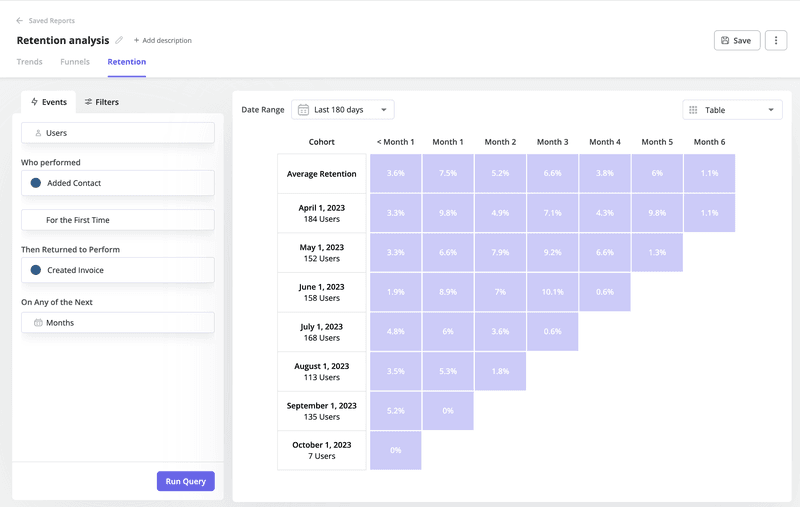
Other growth metrics for SaaS companies
While net MRR growth rate is one of the most important metrics for SaaS companies, it can’t be the only one you rely on. Here are a few more growth metrics you should know about:
- New user growth rate: Percentage of new paying customers the company acquires within a specific time period, as compared to the previous time period.
- Conversion rate: Percentage of users who took a desired action, like making a purchase or signing up, out of all the users who had the opportunity to take that action.
- Average revenue per user (ARPU): The average amount of money a company earns from each of its customers within a specific period.
- Customer lifetime value: The total amount of revenue the customer will bring over the course of their relationship with the business.
- Retention rate: Percentage of customers that remain your customers over a certain period of time, such as on a monthly or annual basis.
- Churn rate: Percentage of customers that cancel their subscriptions or stop doing business with you.
Conclusion
By now, we hope you have learned everything there is to learn about net MRR growth rate and why it is so important to track.
Just remember, your SaaS business should aim for a growth rate of 10-20% to experience valuable growth. And if you’re struggling to achieve such numbers, don’t be afraid to go back to the drawing board and reassess your funnel and retention strategies.
Want to get started with net MRR growth tracking? Get a Userpilot Demo and see how you can improve revenue and reduce churn.






